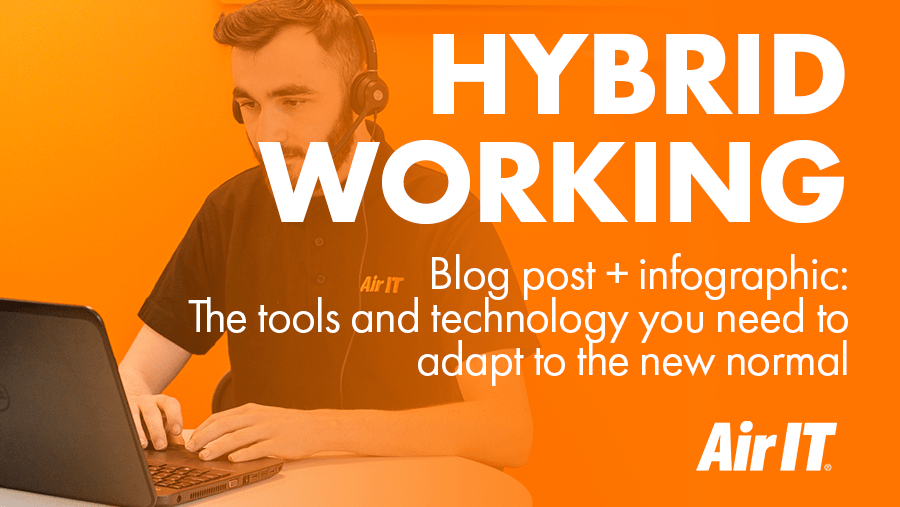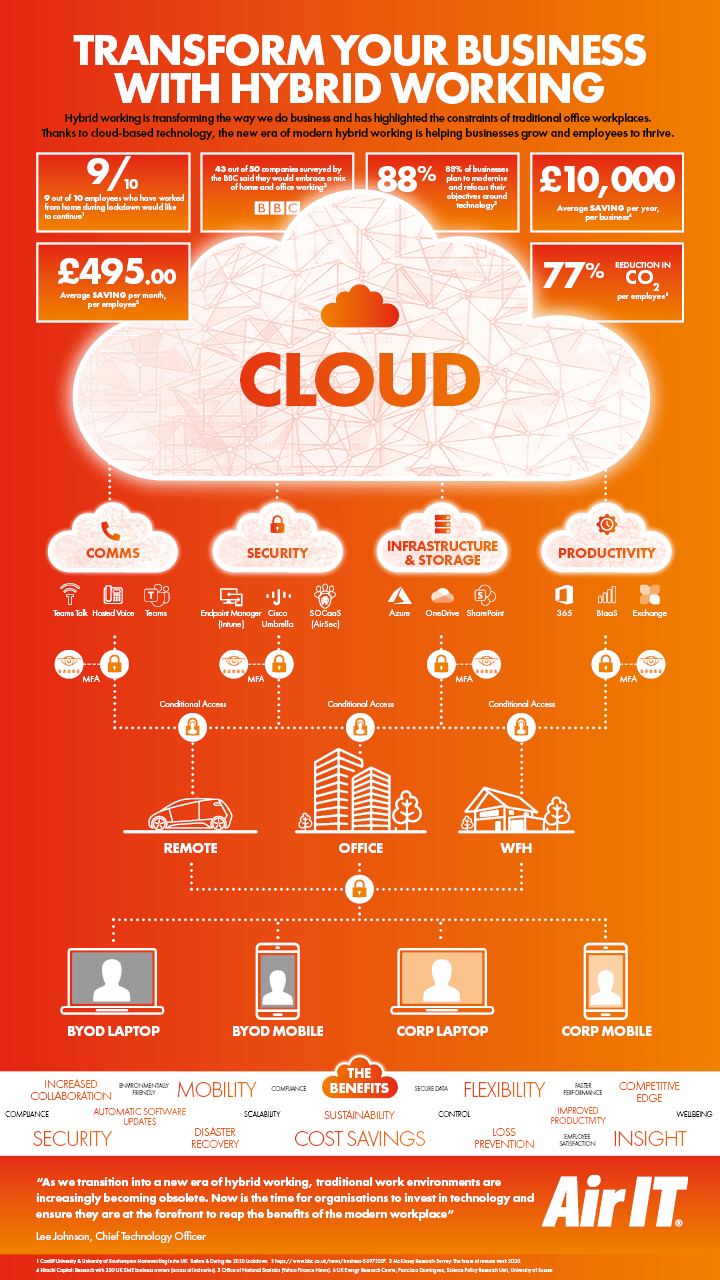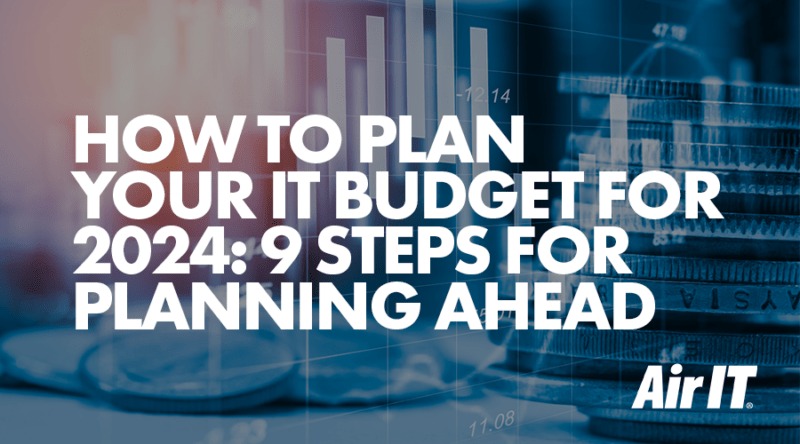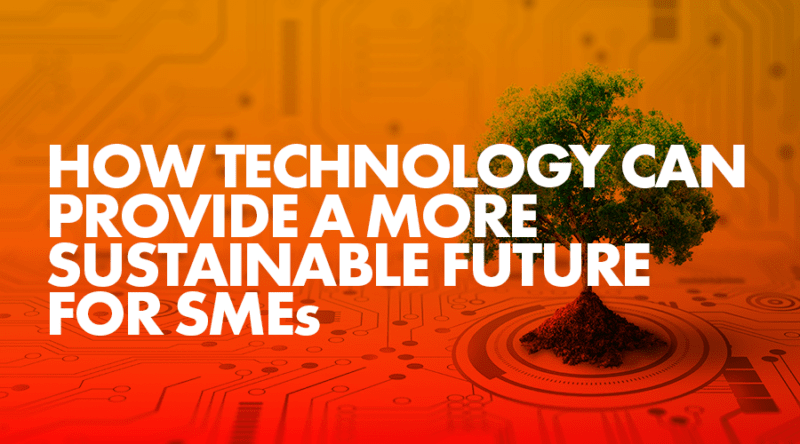As we transition into a new era of hybrid working that blends the office and the home, it’s time to start thinking about the ways we can achieve this. Of course, technology is the key to ensuring employees can uninterruptedly switch from one work environment to another, but what tools and solutions should businesses prioritise in order to thrive in the ‘new normal’? In this article and accompanying infographic, we explain.

Covid-19 revealed the resilience of our IT systems
If there’s one thing the past year has taught us, it’s that technology is critical for businesses’ survival. Whether it’s swapping in-store sales for online orders, office landlines for cloud-based phone systems or boardroom meetings for Microsoft Teams meetings, we’ve all used technology to adapt to the physical separation we’ve encountered.
It has been clear to see that the businesses who embraced modern technologies, and had adopted these in advance, were much better prepared for the transition to remote work, whilst others were left scrambling to get their employees properly set up.
Table of Contents:
-
- Hybrid work is the new normal
- Streamlining legacy systems
- Taking a cloud-based approach
- Modernising your workplace with best-in-class tools
- Keeping colleagues connected across all locations
- Adapting your cyber security strategy for the hybrid workplace
- Forming a data strategy can help you plan ahead
- Helping your employees adapt to new technologies
- Infographic: How to transform your business with hybrid working
- Get your workplace ready for hybrid working
Hybrid work is the new normal
The workplace has now changed beyond recognition. As restrictions begin to ease, we’re about to enter a new period of hybrid work which is a combination of the pre-pandemic office environment and the current home-working setup. A study by Cardiff and Southampton universities found that 9 out of 10 employees who have worked from home during lockdown would like to continue doing so in some form, and 43 out of 50 companies surveyed by the BBC said they would embrace a mix of home and office working.
There are many benefits to embracing this hybrid style of working – it can cut operational costs significantly, and employees don’t have to commute as much which is good for both their purse and the planet.
The problem is that most organisations are using systems that weren’t designed for hybrid work. So, what kind of tools and solutions do we need if we want to enable a hybrid working culture that gives us the best of both worlds, without feeling like there’s a big gap between the two?
Streamlining legacy systems
As technology advances more each day, some organisations find it hard to keep up and, rather than overhauling their existing setup, simply install new systems to work around limitations. This can lead to many outdated applications and systems that aren’t agile enough for the modern workplace.
In an increasingly digital world, it’s important to take stock and review your existing systems to ensure they are fit for purpose – most businesses now plan to modernise and invest in their IT infrastructure. The technology your employees use will underpin their whole experience, so reviewing and upgrading legacy systems is essential to encourage innovation and productivity whilst making your business more agile. Cutting down your technical debt will also help save costs and optimise efficiencies, allowing for further investment in new technologies. If you’re not sure where to start with reviewing your current setup, consider a professional IT audit.
Taking a cloud-based approach
Cloud technology has been a hero during the pandemic. Many businesses were already well accustomed to working in the cloud, and it’s now an integral part of the workplace.
As data is stored in an online server, it allows access to everything employees need to do their job no matter where they are based. This provides the smoothest possible user experience as it facilitates an easy transition between the office and the home, with no reliance on any one location.
Hosted Virtual Desktops are a good example of how the cloud can help – they allow users to access the desktop environment they usually would at work, from any device with an internet connection.
Blog post: What is the cloud, and how can it benefit your business?
Modernising your workplace with best-in-class tools
Working from different locations can be isolating for employees and cause them to collaborate less effectively. Luckily, there are plenty of solutions that enable employees to share their ideas more easily, without it feeling like a chore.
Microsoft Modern Workplace, for example, is an operational setup that uses a suite of Microsoft 365 technologies and productivity applications designed to meet your business needs. It also allows you to automate time-consuming tasks across your business, boosting productivity and allowing employees to focus more on innovation than admin.
Here’s what’s included:
- Microsoft 365 and features including Exchange Online (Email), Power Automate (Workflow Automation), plus all the latest Office applications
- OneDrive/SharePoint for all your file storage and document management needs
- Azure AD, Azure Information Protection and Data Loss Prevention technologies
- Enterprise Mobility + Security, a security solution designed for the cloud-first, mobile-first era that helps protect your organisation from cyber threats
- Apps such as Microsoft Teams and Power BI
Keeping colleagues connected across all locations
Communication and collaboration are two elements of office life that remote working has stifled, though there are plenty of apps and tools that can help us connect with our colleagues.
It’s important to consider the impact that the new hybrid working environment will have on your communications systems and modernise them accordingly.
Many businesses have upgraded to VoIP phone systems such as Hosted Voice in recent years, and they have proven to be the perfect tool for remote and hybrid working. They offer all the functionality of traditional telephony with the bonus of providing flexibility to work anywhere.
Air IT’s Hosted Voice solution even allows for integration with Microsoft Teams via our PSTN breakout solution, Teams Talk, for a fully unified communications system that brings all your internal and external communications into one efficient platform. You can find out more about Teams Talk here.
Microsoft Teams has been one of the most-used collaboration tools since businesses were forced to work from home, and new features are constantly being added to improve user experience. Not only can you message, call and organise video conferences with colleagues instantly, but it also allows you to share and edit documents in real time, present slide decks like a pro and integrate third-party apps with ease.
You can even invest in a Teams Room system that facilitates meetings between employees who are split across office meeting rooms and working from home – and the digital whiteboard within Microsoft Teams means you can all engage with live brainstorming sessions.
Adapting your cyber security strategy for the hybrid workplace
Cyber criminals have taken advantage of the pandemic, leading to an increase in cyber attacks – just four months into the pandemic, it was reported that over £11m had been lost to coronavirus-related scams. The switch to working from home only added to businesses’ vulnerability, with employees less diligent about security protocols, whilst networks and personal devices are being used in ways they weren’t designed for.
Hybrid working brings with it a whole new set of security challenges. How do we encourage safe, secure working and monitor the ways networks and devices are being used, when employees are constantly moving around?
There are a variety of solutions and tools available to help:
- User awareness training is essential as your employees are your main line of defence against cyber crime. Educating them on things like password best practices, suspicious links and the signs of impersonation attacks can make a world of difference in their confidence and vigilance when it comes to keeping your business secure.
- Microsoft Endpoint Manager – part of Microsoft’s Enterprise Mobility + Security suite – includes services and tools that allow you to manage and monitor mobile devices, desktop computers, virtual machines, embedded devices and servers.
One of these is Microsoft Intune, a cloud-based service that allows for mobile device and application management. This means you can control the way your organisation’s devices (e.g. laptops, tablets and mobiles) are used and configure specific policies to control apps. Intune ensures that your organisation’s data stays protected and isolated from personal data when used on personal devices. - Cisco Umbrella is an industry-leading cloud security solution that provides users with the first line of defence against cyber attacks. It lives on your organisation’s PCs and laptops and provides protection against emerging cyber threats, which operates at a different layer to traditional anti-virus and other endpoint protection solutions. Further to this, Cisco Umbrella can also provide staff productivity monitoring and web filtering capabilities. Being a cloud-based solution this allows you to manage and protect employees in all locations.
- Multifactor authentication (also known as two-factor authentication) adds an extra layer of security to the sign-in process. Once a user has entered their password to access an account or app, they must provide an additional method of verification, which is usually a six-digit code sent to their mobile phone. This confirms that the user is who they say they are, rather than a cyber criminal who has wrongfully gained access to their password.
Free webinar download: Protecting your business and users in a remote world
Forming a data strategy can help you plan ahead
The decisions made by business leaders at this time are especially important as we emerge from what has been a difficult period for many. It’s important that any decisions are properly informed and will take your business in the right direction. This can be done by forming a data strategy that helps you prepare for any future disruption and removes the ‘gut feeling’ approach sometimes taken in the decision-making process.
Business intelligence is a method of collecting, organising and analysing a business’ data in order to present accurate insights that drive better, more informed decision-making and optimise performance. Leveraging your data in this way means your whole organisation has one consistent, up-to-date view of historical trends, current threats and KPIs targeting growth areas. A clear, fit-for-purpose data strategy will give businesses the edge over their competitors as we enter the new normal.
Blog post: Covid-19 recovery: How business intelligence can help you get back on track
Helping your employees adapt to new technologies
Learning new tools in a remote environment can be challenging, and many have had to do this in the past year. If you’re introducing a new solution to your technology stack, it’s really important to ensure that staff have had the appropriate training on how to use it. Not only will this help them feel more confident and supported at work, but it will also help them increase productivity and efficiency.
Infographic
Get your workplace ready for hybrid working
Here at Air IT, we’re passionate about helping businesses succeed through technology and have helped countless businesses in the transition to remote and hybrid working. As well as offering IT support, projects and consultancy, we specialise in business comms, cyber security and business intelligence. All of the tools and solutions mentioned in this article are available as part of our range of managed services.
If you have any queries or would like more information on preparing for hybrid work, please don’t hesitate to get in touch.





